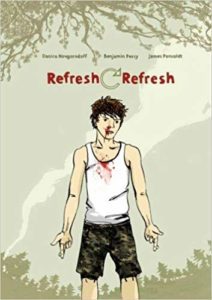
As I write this, a movie based on a series of young adult books about young adult vampires is on its way to having the third biggest box office opening of all time. (Um, the name of the film escapes me right now. If only they had a bigger PR budget…) The bulk of the ticket sales undoubtedly came from the books’ most avid readers; a friend of a friend—forty years old, by the by—went to see it twice on opening day, such was her fervor.
Nothing near the same readymade audience exists for a fantastically raw short story by Benjamin Percy called “Refresh, Refresh,” despite its inclusion in the Best American Short Stories and the Pushcart Prize anthologies. And, most likely, only a fraction of that audience is aware of the story’s transformation into a graphic novel from the pen of Danica Novgorodoff, the writer/artist of the underrated Slow Storm. Which is a shame, because Novgorodoff’s deferential and nuanced take on Refresh, Refresh deserves a readership as wide as the central Oregon valley in which it’s set.
Josh, Cody, and Gordon are high schoolers whose Marine reservist fathers have been in Iraq for far longer than any of them had anticipated. With tours extended and bills coming due, the boys become keenly aware of their social status, their poverty, their lack of options: “We didn’t understand the reason our fathers were fighting. We only understood that they had to fight.”
Left unsupervised—their mothers have remarried or are taking extra factory shifts to keep the lights on—they use a garden hose to form a backyard boxing ring and proceed to bloody each other after school. Unlike the empathy-starved bruisers of Fight Club, these boys don’t do it from some misrouted sense of honor or to promote anarchy. (Plus, Tyler Durden never swung a sockful of pennies.) They fight “to make each other tougher.” They fight because their fathers fight.
Refresh, Refresh thrives on character, not plot—past the absent fathers, there isn’t a sustained external conflict so much as a series of significant moments. The boys cross paths with a jockish bully and a military recruiter named Corey Lightener, who has a reputation for poaching the wives and girlfriends of deployed soldiers. (It’s also Lightener’s job to notify the families of the deceased; for whichever reason, it’s never good to see him on your doorstep.) But the novel’s power comes from how the three boys deal with absence. These boys are waiting: for their fathers, for their uncertain futures to take shape, for the sting of a right hook to affirm that they matter. They continually document their lives, filming their fights and their lonely walks through school hallways, posting heartbreaking messages through webcams; if they don’t put themselves on the record, who will? To avoid facing their post-graduation options, they spend hours in front of their computers waiting for word that their fathers are safe: “We could only cross our fingers and wish on stars and hit refresh, refresh, hoping they would return to us.”
Novgorodoff’s graphic novel is actually two steps removed from the original—she’s working from a film script by James Ponsoldt, who worked from the Percy story. The best dialogue is lifted verbatim from Percy, and occasionally Novgorodoff’s ear for boyhood speech lets her down. (These boys wouldn’t say “darn” and “sissy” when “damn” and “pussy” are available.) But she is a gifted visual storyteller who knows how to let silence do the talking: There are beautiful pages that pass without words, pine trees like stoic sentries behind empty houses, the town haunted by unsold cases of Coors and commercial planes overhead, flying toward somewhere more important. As the story builds momentum, it stockpiles an unnerving stillness, and abandonment becomes an almost tangible fact of these boys’ lives. Much credit must also go to colorist Hilary Sycamore for her lush Oregon greens, stark winter whites, and the unique color palettes for each character.
Novgorodoff renders the boys themselves sparsely, their faces wild with angst. She has a wonderful eye for body language—she nails the awkward gestures and restlessness that come with being teenaged and male, the urge for freedom that makes young bodies seem at once restrictive and indestructible. The lettering, a glossy afterthought in too many comics, suggests the speech of people unformed, in pain, wise but afraid of the world. Even the physical dimensions of the book seem well considered—it’s the size of a literary paperback, scaled down from a standard comic book as if to make the story more intimate.
The ultimate irony is that while solitude stunts the boys’ growth, it also gives them the wherewithal to become men. They move about their town with impunity, hitting up the local bars despite being years too young—the bars need the business, with the grown men all fighting abroad—and recklessly entangling themselves in matters of sex and violent revenge. “Just act like a man and you’ll get treated like one,” Cody says.
With this freedom, of course, comes understanding. Josh dreams of a bleak, featureless, yet unmistakable terror in Iraq, drawn by Novgorodoff in a stunning black-and-white watercolor sequence. It illustrates how much and how little these three understand about what the future holds for them.
If some readers find the beautiful playthings of Twilight: New Moon more easily digestible than these hardscrabble teenagers of the Pacific Northwest, I suppose I understand. We don’t like to put faces to the names of dead soldiers, much less consider the fallout their absence has on the people who wait for them, always, to come home. But I’m thankful Novgorodoff is asking the messy questions, even if the answers make us hurt.




